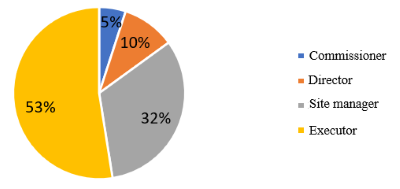Risk Management in Implementation City Road Project in Padang City
DOI:
https://doi.org/10.24036/cived.v11i2.570Keywords:
Risk Identification, Risk Response, Severity.IndexAbstract
Risks can have an impact on the productivity, performance, quality and cost limits of a project and risks can be said to be consequences that may occur unexpectedly. The success of a construction project really depends on the ability of project management to manage the risks that occur. The role of transportation in the city of Padang is to support the economic, education, tourism and defense and security sectors. Construction projects are a dynamic field and contain risks. The aim of this research is to identify risks and carry out risk analysis in the implementation of city road construction projects in the city of Padang as well as carry out risk responses for risk ownership in order to reduce the consequences caused by these risks. This research uses primary and secondary data which will later become a questionnaire and conduct interviews. Questionnaires were distributed to respondents, namely contractors, the results of the questionnaire calculation analysis using the Severity Index (SI) method from during the implementation of urban road construction in the city of Padang, 47 (forty seven) risks were identified based on activities at the project implementation stage. The risks identified are 2 (two) political risks, 7 (seven) environmental risks, 2 (two) planning risks, 2 (two) marketing risks, 3 (three) economic risks, 1 (one) financial risk, 6 ( six) natural risks, 7 (seven) project risks, 7 (seven) technical risks, 2 (two) human risks, 3 (three) criminal risks and 5 (five) safety risks. Of the identified risks, an analysis of the level of risk acceptance was carried out which showed that there were 23 (twenty-three) risks that were included in the highest risk category or unacceptable risk category (Unacceptable) and 24 (twenty-four) risks that were included in the risk category. not expected (Undesirable). Ownership of the greatest risks is the responsibility of the contractor because during the project, the contractor has a central role as controlling the overall course of the project.
Downloads
References
Darmawi, H. (2010). Manajemen Risiko. Jakarta: Bumi Aksara.
Faisal, M. (2021). Analisis Risiko pada Tahap Pelaksanaan Konstruksi Jalan Tol Cinere-Jagorawi, Depok. Jurnal Keilmuan Teknik Sipil Universitas Gunadarma, Vol. 4 No. 2.
Ghozali, I. (2011). Aplikasi Analisis Multivariate dengan Program IBM SPSS 19. Semarang: Badan Penerbit Universitas Diponegoro.
Hidayati, R. (2017). Analisis Variabel-Variabel Risiko pada Pelaksanaan Proyek Konstruksi Jalan. Jurnal Teknik Sipil Politeknik Negeri Padang, Vol. 14, No.2 ISSN : 1858-3695. Padang.
McIntyre, M. G. (2013). In The Basics of Risk Management in Construction Contracts. Bandung: Pustaka Setia.
Moi, F. (2021). Analisis Manajemen Risiko pada Proyek Pembangunan Ruas Jalan Baru Waebetu-Tarawaja. Jurnal Teknik Sipil Politeknik Negeri Bali, Bali.
Ndale, F. X. (2013). Analisis Resiko Pekerjaan Peningkatan Jalan Lintas Selatan Kabupaten Ende, Studi Teknik Sipil, Fakultas Teknik, Universitas Flores Ende, Vol. 7 No. 1
Nyoman, S. (2019). Pengelolaan Resiko yang Mempengaruhi Kinerja Mutu pada Pelaksanaan Proyek Jalan Ciamis-Banjar-Pangandaran-Batas Jateng. Magister Teknik Sipil Universitas Sangga Buana, ISSN:1979-4835.
Oberlender, G. D. (2000). Project Management for Engineering and Construction. McGraw-Hill Companies.
Rantung, B. T. (2018). Pengelolaan Risiko pada Pekerjaan Pembangunan Jalan Tol Manado-Bitung (Sta.9+700 s/d Sta.11+700). Jurnal Sipil Statik Program Studi Teknik Sipil Pasca Sarjana Universitas Sam Ratulangi Manado, Vol. 6, No.5, ISSN:2337-6732. Manado.
Reski, P. (2015). Monitoring Resiko pada Pelaksanaan Performance Based Contract (PBC) Proyek Jalan Nasional di Jawa Timur. Program Studi MMT-ITS, ISBN: 978-70604-2-5. Surabaya.
Revantoro, N. B. (2017). Analisis Risiko Dalam Proyek Jalan Raya di Kabupaten Malang. Jurnal Teknik Sipil Fakultas Teknik Universitas Negeri Malang, Vol. 22, No.1. Malang.
Riza, M. A. (2018). Faktor Penyebab Kerusakan Lingkungan Sekitar Akibat Pembangunan Underpass (Studi Kasus: Underpass Makamhaji, Sukoharjo), Departemen Arsitektur, Fakultas Teknik, Universitas Diponegoro, Vol. 18, No. 2 pp. 97-100.
Rusim, D. A. (2018). Analisis Risiko Terhadap Waktu Pelaksanaan Pada Pembangunan Infrastruktur Jalan Di Jayapura, Program S3 Teknik Sipil, Universitas Hasanuddin, ISSN:2459-9727.
Suliyanto. (2018). Metode Penelitian Bisnis untuk Skripsi, Tesis & Disertasi. Yogyakarta: Andi Offset.
Syammaun, T. (2019). Manajemen Risiko Proyek Konstruksi Jalan (Studi Kasus: Preservasi Rekonstruksi Jalan Lambaro-Bts. Pidie). Program Studi Teknik Sipil, Vol. 8 No.2 Hal. 64-119, ISSN: 2089-6085.
Utama, R. T. (2017). Analisis Tingkat Risiko Proyek Pelaksanaan Pemeliharaan Jalan Untuk Meningkatkan Kinerja Mutu Proyek Jalan di Kabupaten Malang. Program Magister Teknik Sipil Universitas Brawijaya, Vol. 11 No.3, ISSN: 1978-5658. Malang.
Widyantari, I. G. (2018). Analisis Risiko Preservasi Jalan SP. Tohpati-Tampak Siring-Istana Presiden, Kabupaten Gianyar, Provinsi Bali. Magister Teknik Sipil Program Pasca Sarjana Universitas Mataram, Vol. 6 No.1, e-ISSN: 2302-2590. NTB.

Downloads
Published
Issue
Section
License
Copyright (c) 2024 Rifano Putra, Taufika Ophiyandri, Benny Hidayat

This work is licensed under a Creative Commons Attribution 4.0 International License.

